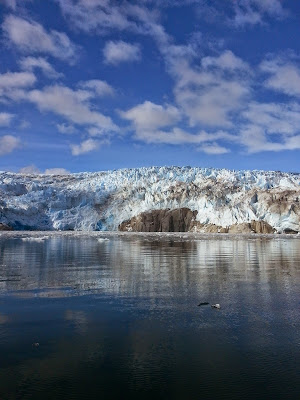Both “Alea” and “Polo Flat”
left Chacabuco last Tuesday and we stopped for the night back in
Gato. We had some drinks and snacks aboard little Polo Flat and said
our goodbyes. We both left with the dawn the following morning –
Alea going south, Polo Flat heading north. That night (Wednesday,
May 6), we spent in one of what I think will be our last uninhabited
anchorages – Caleta Canal (44,52S 73,42W).
You could town-hop if you wanted up
here, which is a major difference from the months we spent down
south, where we didn't see anyone else for weeks at a time. I assume
there are more settlements because it is just a bit more hospitable
than the colder more temperamental southern channels, and also
because there is significantly more exploitation of the marine
resources. Most notable are the many salmon and mussel farms.
Maintaining these farms requires more boat traffic and more people.
As a result, the environment is also changing - loads more trash on
shore and a lot less marine life. We've noticed in our few times
anchored with fishing boats the general lack of concern for where
waste goes. Whole styrofoam blocks and garbage bags over the side,
diesel in the water – the ocean is treated as a dump. I suppose
this is the mentality of most of us humans wherever we are: if we
don't see our waste any longer, then it no longer exists or has any
impact. Unfortunately, that is very untrue and the effects are
rather evident in this fragile Patagonian ecosystem.
Alright, enough preaching and back to
our travels. Thursday, May 7 we decided to push up to a very safe
spot, a small marina and eco-resort on Isla Jechica (44,24S 73,51W).
The resort is closed for winter, but the marina is still useable and
it provides excellent shelter in bad weather. It is a gorgeous spot
and the resort has been beautifully and unobtrusively built into the
surrounding environment. I can imagine that it would cost quite a
bit of money to be here in season, but we were very lucky to enjoy
the trails and some of the amenities all to ourselves and for free.
Though the electricity is off for the winter, the caretaker who lives
across the bay from the resort property allowed us to use one of the
houses a bit. The showers were hot, wood-fired from the living room
fireplace, the couches were cozy, and it was awesome having a little
space off the boat to relax and spread out the yoga mat!
We left Jechica yesterday to check out
another anchorage just a few miles north, Caleta Valverde (44,20S
73,46S). We spent the afternoon exploring the crazy plant life and
rock formations on shore and then tucked in away from predicted bad
weather. We had lots of wind and our first thunderstorm of the trip
last night! It all passed through, leaving us with a beautiful
sunset this morning and some sailable mild wind today. We're covering
great ground and will hopefully be in Chiloe just after the weekend. For now, a new village while we wait out a big system.
Current position (Wednesday, May 12): Puerto Melinka, 43,53S 73,44W
 |
| Alea and Polo Flat |
 |
| Hitchhikers! |
 |
| wood-fired hot tub |
 |
| at Jechica |
 |
| Casa Tripulantes, a welcome refuge! |
 |
| Jechica |
 |
| Caleta Valverde |
 |
| Berries |
 |
| Weird Fungus |
 |
| quartz layers |
 |
| sunrise |









































